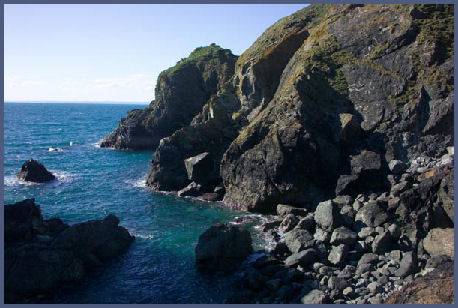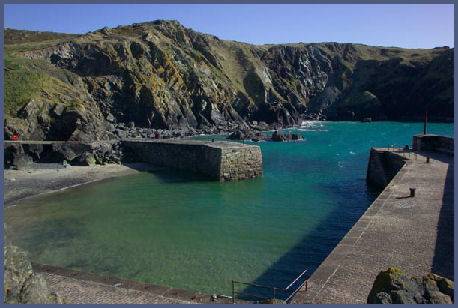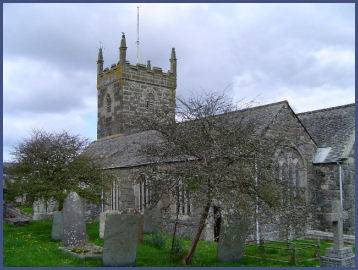Mullion Cove
OS Grid ref:- SW666181
Beautiful Mullion Cove on the Lizard Peninsula has an attractive working harbour, protected from raging winter gales by two strong harbour walls which were completed in 1895 and financed by Lord Robartes of Lanhydrock to compensate local fishermen for several bad pilchard seasons.
Mullion Cove


There is a small, sandy beach in the harbour at low tide, a car park is provided which is a few mnutes walk from the harbour. The cove, known in Cornish as Eglosvelyan, has been owned and maintained by the National Trust since 1945, while most of the cliffs and heathland south of Mullion Cove are managed by English Nature and the National Trust.
The cove overlooks Mullion Island, famous for its sea birds, some of the Lizard's most spectacular cliff top scenery can be seen from Mullion to Kynance Cove. Mullion village, situated around a mile (2km) from the cove, is the largest village on the Lizard Peninsula and has a selection of shops, banks, restaurants, two inns and a post office, the thatched roofed Old Inn at Mullion dates to the sixteenth century and serves fine locally sourced food.
The church of St. Mellanus
 The village church, dedicated to St. Mellanus, or St. Malo, a sixth century Welsh saint and missionary, is located at the centre of the village. The church has a Cornish barrel type roof, the original wood pegged roof timbers are reputed to have come from Goonhilly Forest, which in the Medieval era still covered Goonhilly Downs.
The village church, dedicated to St. Mellanus, or St. Malo, a sixth century Welsh saint and missionary, is located at the centre of the village. The church has a Cornish barrel type roof, the original wood pegged roof timbers are reputed to have come from Goonhilly Forest, which in the Medieval era still covered Goonhilly Downs.
The exact age of the church is uncertain, its chancel and beautiful serpentine motif font are of thirteenth century origin, while its tower was erected about 1500 by was erected by Robert Luddra , vicar of Mullion. The tower is constructed of local serpentine and granite which gives it a variegated effect.
The ancient wooden studded oak North Door dates date from the eleventh century and is believed to have derived from an earlier church on the site. It contains a curious flap 'dog-door', to enable the local sheep dogs to pass freely in and out of the building. Above the door is displayed the Royal Coat of Arms, which were bestowed by the Stuart King, Charles II (1660-85).
The church contains some superb elaborately carved sixteenth century oak bench seats, which date from the sixteenth century and depict biblical scenes, including the tale of Jonah and the whale. Over the west window is a single piece of granite on which is carved an unusual Crucifixion , which is very reminiscent of the kind of work found on some early crosses.
Image copyright Jim Dugdale
Bronze and Iron Age burial mounds surround the village. Nearby are the remains of the Wheal Unity Copper Mines which operated from the early eighteenth century to 1909.
Towns and Villages of Cornwall